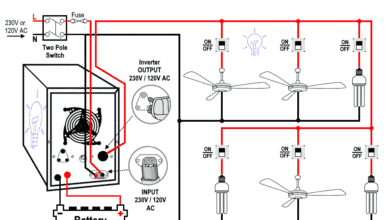How Does a Standard Breaker Respond to Electrical Fault?
How Does an Ordinary Circuit Breaker Operates During Short Circuit, Overload & Ground Faults?
When a standard circuit breaker detects a fault, such as an overload or short circuit, it responds by interrupting the current flow. The breaker “trips” to prevent excess current from damaging the circuit, overheating the wires, or causing a fire. This protective action helps ensure the safety and integrity of the electrical system.
A standard circuit breaker responds to both short circuits and overloads by cutting off the current to protect the circuit:
- Short Circuit:
When a short circuit occurs, a sudden surge of current flows through the circuit. The breaker detects this sharp increase in current and trips almost instantly, stopping the flow to prevent potential damage, overheating, or fire.
- Overload:
During an overload, the current gradually exceeds the circuit’s safe capacity due to the connection of too many devices or a high-demand appliance. The breaker senses this excess current over a short period, heats up, and eventually trips to protect the wiring from overheating and causing damage.
Related Posts:
- How Do GFCI and Standard Breakers Respond to Ground Faults?
- Why Doesn’t a Standard Breaker Protract Against Ground Faults?
How a Standard Circuit Breaker Operates During Electric Faults?
A typical circuit breaker cannot detect ground faults or the absence of a neutral. Instead, a standard breaker only provides protection against short circuits and overloads. This is why the National Electrical Code (NEC) mandates the use of Ground Fault Circuit Interrupter (GFCI) breakers for proper protection of both devices and personnel.
Let’s look at how a standard breaker behaves under normal and fault conditions in the following circuit examples.
Normal Condition
In the following diagram, a lighting circuit is controlled and protected by a 15-amp breaker, supplied with 120V from a 120V/240V main panel.
Since there is no fault in the circuit, everything operates normally, and the light glows as expected.
Short Circuit / Overload Condition
Now, suppose a short circuit or overload occurs, such as when the hot wire contacts the metallic body of a device (e.g., the bulb holder). In this case, fault current finds a path back to the source via the ground wire. The ground wire is bonded to the neutral wire at the main panel, allowing circuit completion.
Because the resistance of the ground wire is very low, a large amount of current (up to 600 amps) flows through the circuit. This high short-circuit current causes an overload. The internal mechanism of the breaker detects this excess current and responds by tripping. The 15-amp breaker then disconnects the circuit from the main power supply, protecting both the device and personnel from harm.
Fault Detection and Tripping
As shown in the diagram below, the 15-amp breaker trips after detecting fault current that exceeds its rated capacity. This disconnects the circuit from the main supply, offering protection against overloads and short circuits.
Related Posts:
- Why are Neutral and Ground Wires Separated in a Subpanel?
- Why Must Neutral and Ground Wires Be Bonded in the Main Panel?
- What Happens if the Neutral is Lost in the Main or Subpanel?
Standard breaker in Ground Faults:
As discussed above, ordinary circuit breakers do not provide protection against ground faults, where electricity unintentionally flows to the ground, or against broken neutral conditions, which can present significant safety risks. In these situations, current may flow through the source (in the case of a lost neutral) or to the ground (in the case of a ground fault), potentially completing the circuit through unintended pathways.
This can result in current flowing through improper channels, including the neutral and ground conductors. Additionally, any exposed metal parts in the circuit may become energized, potentially carrying dangerous voltages of 72V or 120V, creating a serious hazard.
To address this issue, a GFCI breaker should be used instead of a standard breaker to ensure safety in the event of ground faults.
A standard circuit breaker is designed to protect against overloads and short circuits. However, standard breakers do not protect against ground faults, or against broken neutral conditions, which can create additional safety risks. The National Electrical Code (NEC) mandates the use of Ground Fault Circuit Interrupters (GFCIs) which are specifically designed to detect ground faults and provide enhanced protection.
Resources & Tutorials:
- National Electrical Code (NEC) Requirements for Panelboards
- How to Find the Right Wire Size for 100A Service 120V/240V Panel?
- How to Determine the Right Size Capacity of a Subpanel?
- How to Wire a Subpanel? Main Lug Installation for 120V/240V
- How to Determine the Number of Circuit Breakers in a Panel Board?
- How to Size a Load Center, Panelboards and Distribution Board?
- How to Wire 120V & 240V Main Panel? Breaker Box Installation
- How to Wire a GFCI Circuit Breaker?
- How to Wire and Install an Electrical Outlet Receptacle?
- How to Wire a GFCI Outlet?
- How to Wire GFCI Combo Switch and Outlet
- What Happens When You Touch an Electrical Busbar?
- Can the Neutral Wire Cause Electric Shock? Different Cases
- Difference Between Grounding, Earthing and Bonding
- Difference Between Neutral, Ground and Earth?
- Will I Get an Electric Shock If I Touch the Ground Wire?
- Will a Man Get an Electric Shock If He Hangs on a Live Wire?
- Difference Between Circuit Breaker and GFCI
- Tripping Curves of Circuit Breakers – B, C, D, K and Z Trip Curve











